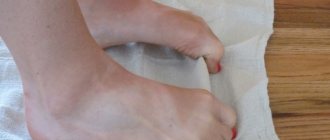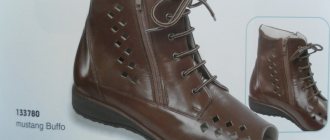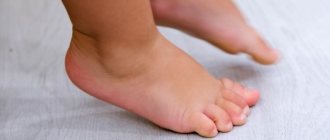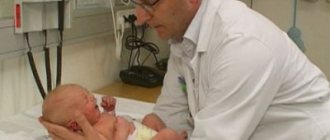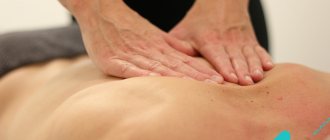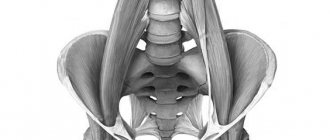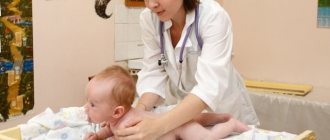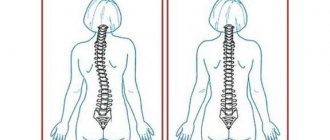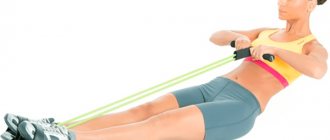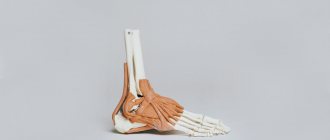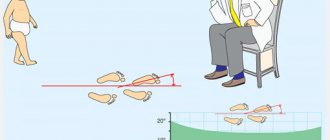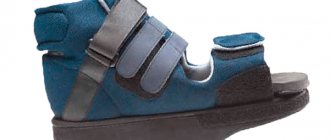Treatment of varus deformity in children is a long and painstaking process, which consists of complex therapy using massage and physical therapy. These two methods have proven themselves to be positive, as they have proven to be effective provided that the techniques for performing the procedures are used correctly. In adult patients, they are used in the postoperative period as part of auxiliary therapy after solving the problem through surgery.
The orthopedist individually selects appropriate exercises for varus deformity, based on the degree of curvature.
What causes?
The foot of a child under 3–4 years old is very different from the foot of an adult. The structure of bones contains a lot of water and cartilage tissue, which is less durable than bone. Underdeveloped muscles and ligaments. Therefore, under the influence of negative internal and external factors, its proper development may be disrupted.
The formation of varus deformity of the feet in children usually occurs immediately after birth or in early childhood.
She is called:
- difficulties of intrauterine development (oligohydramnios, multiple pregnancies, abnormalities in the structure of the uterus, past infections and disorders of the fetal nervous system);
- endocrine pathologies;
- hereditary predisposition;
- injuries;
- chronic infectious and inflammatory diseases that weaken the body;
- vitamin D deficiency;
- impaired absorption of calcium;
- incorrectly selected shoes;
- early attempts to put the baby on his feet and early walking.
Varus is not always a pathology. It is often caused by muscle hypertonicity in infants, after which the position of the foot is normalized.
Foot massage for children
The ultimate causes of acquired varus curvature are gravity and tissue compliance. When a child first stands on his legs, he has no deformities; they are acquired gradually if favorable conditions have developed for them. And the primary causes can be different: genetic, lack of substances needed by the body (rickets), injuries, decreased muscle tone, etc. The most likely cause of varus deformity of the legs is a lack of components to create strength in the bones and cartilage. In rickets, for example, calcium may be present in the body and even be supplied there in excess, but absorption requires active vitamin D, which is formed from ultraviolet radiation.
How to detect?
It is quite difficult for parents to independently notice the first signs of foot varus in their baby. Until he starts walking, they don't even know there's a problem. The disease develops slowly. Obvious signs of deviation do not appear immediately. A characteristic and obvious symptom of varus deformity in children is changes in the lower extremities, when in a standing position the legs are tightly pressed to each other and the knees do not close. The position of the legs resembles the letter "O".
Parents can suspect varus foot deformity in a child based on the following markers:
- erasing the soles of shoes from the outside, where the load and pressure are greater;
- outward deviation of the feet;
- awkward, uncertain gait;
- frequent falls when walking or running;
- leg pain;
- Difficulty straightening your knees.
What external changes in the legs look like with varus deformity of the feet in children can be seen in the photo:
What can the disease lead to?
Mild clubfoot is natural for young children, since their musculoskeletal system is not fully formed. Sometimes parents don't pay attention to this. But as varus deformity progresses, the child may become disabled. This means that if a child develops clubfoot, he or she needs to be examined by an orthopedic surgeon.
In addition to the negative impact on gait, varus deformity leads to the development of flat feet. This is due to improper distribution of weight on the foot. Also, with such a deformation, bones and joints that are nearby can be affected. Therefore, incorrect biomechanics of all joints may develop. Another negative consequence of clubfoot is the appearance of excess weight. This symptom is characteristic of people with pathologies of the musculoskeletal system. As a result, progression of the disease will become inevitable. Regardless of the type of foot deformity, you need to get rid of excess weight. All doctors recommend this.
People with flat feet do not always find it easy to run long distances. Today you can choose any activity that will help you quickly lose unnecessary weight. This is possible under any prolonged cyclic loads. They are available to everyone: swimming, cycling, skiing and others.
With pathological changes in the shape of the foot, premature wear of the joints that are located above occurs. If you were diagnosed with clubfoot in childhood, health problems may begin in adulthood. One of these consequences is the development of progressive arthrosis with knee pain.
How to treat?
To check whether everything is in order with the installation of your baby’s feet, contact a pediatric orthopedist. Only a doctor, after consultation and examination, is able to make the correct diagnosis.
Unlike adults, varus deformity in children is much easier to correct. This is due to the greater “pliability” of muscles, bones, and tendons. Before school age, everything can be corrected, since the formation of the foot is not yet complete. The main thing is to start treatment on time.
Conservative and surgical methods are used for correction.
Treatment of varus foot deformity in children includes:
- exercises, gymnastics;
- physiotherapeutic procedures;
- walking on massage mats;
- orthopedic insoles, screeds, instep supports, correctors;
- giving the child a therapeutic foot massage.
With varus deformity of the foot, children are prescribed shoes that prevent external rotation. It's called anti-virus. Helps in the early stages to quickly correct varus curvature of the child’s legs and correctly distribute the load on the immature leg. These shoes have high, rigid lateral fixation of the foot and heel, and a special orthopedic insole.
Massage
Foot massage for varus deformity of the foot in a child helps strengthen weakened muscles and ligaments, form the correct position of the legs, and improve blood circulation. Massage movements include rubbing, stroking, and kneading. The massage must be performed by a certified master as prescribed by an orthopedic doctor. This massage is not limited to working the foot.
It begins with the back and lower back, then pays special attention to the thigh, lower leg, plantar part of the foot, ankle and knee joints. It is performed on a regular basis in courses of 10–20 procedures daily or every other day with a break between courses of 1–2 months.
Massage for planovalgus feet
Massage for planovalgus feet is indicated if, at an appointment with an orthopedist, the baby was diagnosed with planovalgus feet - this means that the vertical line of the heel deviates inward and the inner edge of the foot drops. Or if you yourself suspect this problem. We tested the position of the baby’s feet according to my instructions in the chapter “Planovalgus feet in children”, then without delay you need to start classes according to the method given below. These are the basic techniques of classical massage for planovalgus feet with an emphasis on the feet and legs, plus special exercises for the feet. The first set of classes is age-matched for my youngest patients, 10-15 months.
The training package includes:
• massage of legs and back with a course of 10 procedures. The need for back massage is due to the fact that when the feet are placed in valgus, the child’s spine suffers.
• therapeutic exercises, which should begin on the same day as the massage and last twice as long, at least 20 sessions.
To get a good result:
• gymnastics classes must be carried out in panties, not diapers;
• the effect of massage and gymnastics should be secured by wearing corrective shoes, which we will talk about in a separate chapter;
I would like to draw your attention to the fact that success will depend on the regularity and duration of classes. And also, at what age will you start exercises and massage for planovalgus feet. I strongly recommend that you do not wait until your child reaches the age of three. The older the child, the more difficult it is to correct the feet.
For general rules of massage, see the link Children's massage: recommendations. Read exercises for flatfoot feet in the next post. Let's start with a massage.
Massage for planovalgus feet
Start the massage from the foot. Place your baby on his back with his feet facing you. With one hand, grasp the baby's leg at the shin area. In this case, the leg should be slightly bent at the knee and hip joints.
The first technique is stroking the foot
foot stroking technique
Wrap your toes across the foot in the area of the baby's toes. In this case, your big toe should be on the plantar side, and the remaining toes on the back of the foot. Stroking towards the ankle joint. Repeat the procedure 5-7 times.
The second technique is rubbing the foot
rubbing the foot from the sole
Holding the back of the foot, use the ball of your thumb to rub the sole with spiral, progressive movements from the heel to the child’s toes. Repeat the technique in 3-5 passes. Focus on the place where the longitudinal arch of the foot is formed. Rub the inner edge of the foot especially carefully.
rubbing the toes
Next, proceed to rubbing each finger in turn. To do this, grab the tip of your toe with your three fingers and, with progressive rubbing movements, reach its base. Repeat the technique in 3 passes for each finger separately.
stroking the back of the foot
If your fingers curl up, then you need to straighten them. To do this, additionally stroke the back of the foot from the base of the toes to the ankle joint. Repeat the technique 4-5 times and you will see how your toes begin to relax and straighten.
The third technique is stroking the shin.
stroking the shin from foot to knee
Place your palm around the child's shin above the ankle joint. Run your hand along the shin with sliding movements towards the knee joint. Repeat stroking 3-5 times.
The fourth technique is rubbing the inside of the shin.
Hold the child's shin with one hand, while the leg should be slightly bent at the knee joint. Move the pads of your fingers in progressive spiral movements towards the knee joint. Repeat the procedure 3-5 times. The anterior surface of the lower leg is not massaged.
Finish the lower leg massage by stroking from the foot to the knee joint and then to the hip joint. Repeat the procedure 2-3 times.
If you have any questions, ask them on the forum. I have a page on Instagram, subscribe to stay in touch. My online osteopath channel in telegram.
How is it different from equinovarus pathology?
Let's look at these aspects in tabular form.
| Options | Equinus | equinovarus |
| Concept | A deviation that manifests itself in a change in the bend of the sole. It is with this disease that the name is associated - horse foot. This is a common option. | Plantar mixing occurs. The side goes up to the shin, and the outside goes down. Somewhat reminiscent of clubfoot, but in a very strong form. |
| Visual aspect | The symptom is noticeable immediately. The person begins to walk literally on tiptoe. Lean on your fingers and knuckles. Which in itself is very dangerous and leads to the loss of functionality of these parts of the body. | A person walks on the edge of the sole, the leg takes an extremely unnatural position. |
| Reasons and sources | Often, pathology begins to be observed at the child’s developmental stage. An acquired disorder that can be avoided by preventive methods. | In most cases, character is innate. Only treatment is implied, prevention is not widespread. |
Possible complications and their consequences
It all depends on the severity of the disease, treatment time, and individual characteristics of the body. Affection on one side can easily lead to chronic lameness. And if both sides were affected, the result is often a high level of disability.
Osteochondrosis, arthritis, and scoliosis can also be caused. Increased fatigue, disruption of the normal metabolic balance. The circulatory system can also be affected, which can have its own negative consequences in the future.
What to do for joint pain
It is worth immediately clarifying that if your baby complains or demonstrates the presence of pain in the joints of the leg, you should not immediately suspect ballerina syndrome or related ailments. You should first seek medical advice. It is strictly not recommended to take any medications unless your doctor personally recommends or prescribes them.
Of course, for mom, the psychological factor shifts a little towards fanatical care. But surgical treatment measures, if carried out incorrectly, or if intervention was not required, can only do harm. If your child has a slight limp on his right leg, this does not mean that he has an equinus deformity of the right foot. This is just a slight suspicion. Therefore, you should not urgently run for medications and ointments, but purchase orthopedic shoes and make an appointment with your treating pediatrician.
Prevention
Preventive measures to prevent the occurrence of pathology include:
- Maintaining an active, mobile lifestyle for a child. Initiate regular walks and exercises.
- Proper, complete and balanced nutrition. As we have already clarified, calcium deficiency, for example, may well become the basis of pathogenesis.
- Choosing the right shoes for your child, as we have already discussed above.
- Fighting excess weight. After all, obesity can be a compelling reason for the development of ballerina syndrome. Increased load on the ankle provokes a change in the position of the leg, incorrect positioning.
Exercises for patients
And now a few examples of how you can do exercises at home to combat the disorder:
- Spread your toes in different directions and sit completely on the floor. And fixate in this position for an average of 5 to 15 minutes. You can entertain your baby with some kind of game at this time.
- While sitting on a chair, move the rubber ball along the floor, applying increased pressure to the entire plane using your legs.
- Manipulate small objects by lifting and lowering them with your toes, and not, as the child is used to, with your hands.
If foot equinus is suspected, these small techniques can be effective in promoting recovery.
Diagnostics
The final diagnosis can only be made by the doctor you are seeing. Of course, some symptoms are noted by the parents themselves, which may be a reason to visit a doctor. Fortunately, all these deviating aspects are easily noticed visually, they simply catch the eye. But still, only a doctor is able to clearly determine equinus of the foot ICD 10 - Q66. And only after conducting certain studies. These are radiography, plantography, biochemical blood and urine tests. As well as any other additional procedures that may be prescribed if suspicions arise.
